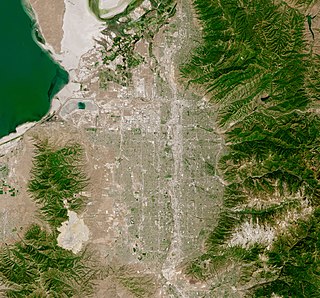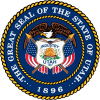
An earthquake is the shaking of the surface of the Earth resulting from a sudden release of energy in the Earth's lithosphere that creates seismic waves. Earthquakes can range in intensity, from those that are so weak that they cannot be felt, to those violent enough to propel objects and people into the air and wreak destruction across entire cities. The seismicity, or seismic activity, of an area is the frequency, type, and size of earthquakes experienced over a particular time period. The word tremor is also used for non-earthquake seismic rumbling.

The San Andreas Fault is a continental transform fault that extends roughly 1,200 kilometers (750 mi) through California. It forms the tectonic boundary between the Pacific Plate and the North American Plate, and its motion is right-lateral strike-slip (horizontal). The fault divides into three segments, each with different characteristics and a different degree of earthquake risk. The slip rate along the fault ranges from 20 to 35 mm /yr. It was formed by a transform boundary.

The 1811–1812 New Madrid earthquakes were a series of intense intraplate earthquakes beginning with an initial earthquake of moment magnitude 7.2–8.2 on December 16, 1811, followed by a moment magnitude 7.4 aftershock on the same day. Two additional earthquakes of similar magnitude followed in January and February 1812. They remain the most powerful earthquakes to hit the contiguous United States east of the Rocky Mountains in recorded history. The earthquakes, as well as the seismic zone of their occurrence, were named for the Mississippi River town of New Madrid, then part of the Louisiana Territory and now within the U.S. state of Missouri.

The New Madrid Seismic Zone, sometimes called the New Madrid Fault Line, is a major seismic zone and a prolific source of intraplate earthquakes in the Southern and Midwestern United States, stretching to the southwest from New Madrid, Missouri.

Salt Lake City is located in a large valley, the Salt Lake Valley, separated by the Wasatch Mountains to the east and the Oquirrh Mountains to the west. Salt Lake City is located at 40°45'17" North, 111°53'33" West.

The Traverse Mountains, or sometimes Traverse Range, are an anomalous, geologically complex, east-trending range that separates Salt Lake Valley and Utah Valley in Salt Lake and Utah counties in the U.S. State of Utah.

The San Jacinto Fault Zone (SJFZ) is a major strike-slip fault zone that runs through San Bernardino, Riverside, San Diego, and Imperial Counties in Southern California. The SJFZ is a component of the larger San Andreas transform system and is considered to be the most seismically active fault zone in the area. Together they relieve the majority of the stress between the Pacific and North American tectonic plates.

The 1983 Borah Peak earthquake occurred on October 28, at in the western United States, in the Lost River Range at Borah Peak in central Idaho.
The 1867 Manhattan earthquake struck Riley County, Kansas, in the United States on April 24, 1867, at 20:22 UTC, or about 14:30 local time. The strongest earthquake to originate in the state, it measured 5.1 on a seismic scale that is based on an isoseismal map or the event's felt area. The earthquake's epicenter was near the town of Manhattan.

The 1916 Irondale earthquake struck in the north–central region of the U.S. state of Alabama on October 18. The strongest earthquake in state history, it registered an estimated Richter scale magnitude of 5.1 and resulted in extensive, but minor damage. This damage, limited to Shelby and Jefferson counties, reached its maximum severity near the epicenter in the city of Irondale, including cracked windows, fallen chimneys, and dried-up wells. While there were no fatalities, the earthquake spawned widespread panic, sending alarmed workers from tall buildings.

The Teton fault is a normal fault located in northwestern Wyoming. The fault has a length of 44 miles (70 km) and runs along the eastern base of the Teton Range. Vertical movement on the fault has caused the dramatic topography of the Teton Range.
The 1979 Imperial Valley earthquake occurred at 16:16 Pacific Daylight Time on 15 October just south of the Mexico–United States border. It affected Imperial Valley in Southern California and Mexicali Valley in northern Baja California. The earthquake had a relatively shallow hypocenter and caused property damage in the United States estimated at US$30 million. The irrigation systems in the Imperial Valley were badly affected, but no deaths occurred. It was the largest earthquake to occur in the contiguous United States since the 1971 San Fernando earthquake eight years earlier.
The 1935 Helena earthquake occurred at in Montana, with an epicenter near Helena. It had a magnitude of 6.2 on the surface wave magnitude scale and a maximum perceived intensity of VIII (Severe) on the Mercalli intensity scale. The temblor on that date was the largest of a series of earthquakes that also included a large aftershock on October 31 of magnitude 6.0 and a maximum intensity of VIII. Two people died in the mainshock and two others died as a result of the October 31 aftershock. Property damage was over $4 million.
The 1979 Coyote Lake earthquake occurred at on August 6 with a moment magnitude of 5.7 and a maximum Mercalli Intensity of VII. The shock occurred on the Calaveras Fault near Coyote Lake in Santa Clara County, California and resulted in a number of injuries, including some that required hospitalization. Most of the $500,000 in damage that was caused was non-structural, but several businesses were closed for repairs. Data from numerous strong motion instruments was used to determine the type, depth, and extent of slip. A non-destructive aftershock sequence that lasted throughout the remainder of the month was of interest to seismologists, especially with regard to fault creep, and following the event local governments evaluated their response to the incident.
The Utah Seismic Safety Commission (USSC) is a legislatively created independent advisory board that tends to seismic-hazard issues in Utah, United States. The Utah legislature created the 15-member commission in 1994 to supersede the Utah Earthquake Advisory Board and to act as a medium “for state and local governments, the private sector, and the public to advance earthquake-related issues by developing, researching, and recommending seismic policies and approaches aimed at reducing Utah's earthquake hazards and managing Utah's earthquake risk.”

The Olancha Earthquake Sequence (2009) was a consecutive series of three earthquakes, with magnitudes of 5.2, 5.0 and 4.9 respectively, with a number of small shocks between each, to accompany the main "triple shock".
At 7:09 AM MDT on March 18, 2020, a 5.7 magnitude earthquake hit Salt Lake City, Utah, United States, with an epicenter 6 km (3.7 mi) north-northeast of Magna, Utah, beneath the site of the planned Utah Inland Port. It was the first major earthquake to occur within the Salt Lake Valley since the city was founded, the state's strongest earthquake since the 1992 St. George earthquake, and the first earthquake of comparable magnitude to occur near Salt Lake City since 1962, when a magnitude 5.0 earthquake struck a similar location in Magna.

The 1839 Ava earthquake, also known as the Amarapura earthquake or Inwa earthquake was a disastrous seismic event that struck central Burma on the morning of March 23. This earthquake with a moment magnitude as high as 8.3, was one of the biggest in the country since 1762. Shaking reached XI (Extreme) on the Modified Mercalli intensity scale, and was felt in Rangoon and Bhamo.
The 1870 Charlevoix earthquake occurred on 20 October in the Canadian province of Quebec. It had a moment magnitude of 6.6 Mw and a Modified Mercalli intensity rating of X (Extreme). The town of Baie-Saint-Paul was seriously damaged by the event, with the loss of six lives. Effects from the earthquake were felt as far as Virginia and along the New England coast of the United States.
The 1915 Imperial Valley earthquakes were two destructive shocks centered near El Centro, California on June 22. The earthquakes measured 6.25 and occurred nearly one hour apart at 19:59 and 20:57 PST. Both shocks were assigned VIII (Severe) on the Modified Mercalli intensity scale. Heavy damage occurred in the areas of Mexicali and El Centro, amounting to $900,000. At least six people were killed in the earthquakes.















